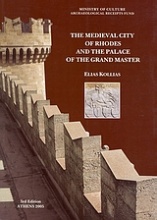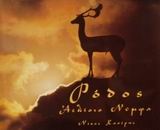The Medieval City of Rhodes and the Palace of the Grand Master
Η μεσαιωνική πόλη της Ρόδου και το παλάτι του Μεγάλου Μαγίστρου
In 1988, a few months before the Summit Meeting of the EEC in the Grand Master's Palace in Rhodes, I was asked by the then political head of the Ministry of Culture to write a small booklet about the Palace to be distributed to the delegates of the member states of the EEC and the journalists. In the end the booklet became a book and much larger in content and length than had originally been commissioned. It seemed to me hardly possible to present the Palace of the Grand Master without reference to the rest of the medieval city, of which it was always the heart. I must also confess that the idea had crossed my mind many years ago of writing and publishing a book that would give a condensed picture of the medieval city of Rhodes complete with its historical background. Thus the form of the book "The City of Rhodes and the Palace of the Grand Master" was dictated on the one hand by the intentions of those responsible at the Ministry of Culture and on the other by my own long cherished ambitions. The venture, in which I also involved my colleagues in the Publications Direction of the Archaeological Receipts Fund (TAP), was a bold one and not without its hazards. Time was very short for writing a book that would be both a scholarly work and a worthy publication, particularly in view of the fact that I was fully occupied, twelve hours a day, in renovating and equipping the palace in preparation for the Summit Meeting. It seemed at times as though the text would never be finished. In the Palace, when we removed the plaster with which the Italians had covered the walls, or made small exploratory soundings in the floors for the requirements of the work, new evidence emerged. This frequently contradicted the conclusions of earlier scholars, and also my own, which were based on all the new evidence, evidence, however, which was continually and rapidly changing. The manuscript was finally delivered, at which point Mrs Evangelia Kypraiou, head of the Archaeological Receipts Fund Publications Direction, and her colleagues were confronted with the aunting task of having the text translated into English and printed on time. I must say that their achievement of this was a feat in itself. I should point out that the book published here is not exactly the same as the one which appeared &lsfl m 1988. Not only have the omissions and errors which were inevitable at the time due urgent deadline been corrected, but also some ten years have passed since then, and in the me mucn has changed. Excavations have uncovered new evidence, especially for the early fortifications of the medieval city, and many new studies on its archaeology and history have appeared. The picture today, of the medieval city therefore, is not the same as that in 1988, and it is this new picture that I have tried to impart here. [...] (από τον πρόλογο του βιβλίου)
- ISBN978-960-214-912-6
- Ημ/νια Έκδοσης2005
- Σελίδες192
- ΔέσιμοΜαλακό εξώφυλλο
- Γλώσσα ΠρωτότυπουΕλληνικά
- Διαθέσιμες Γλώσσες
- Κατηγορίες Βιβλίου
- Θεματολογίες Βιβλίου
- Φωτογράφος
- Συγγραφέας
Σχετικά Βιβλία





